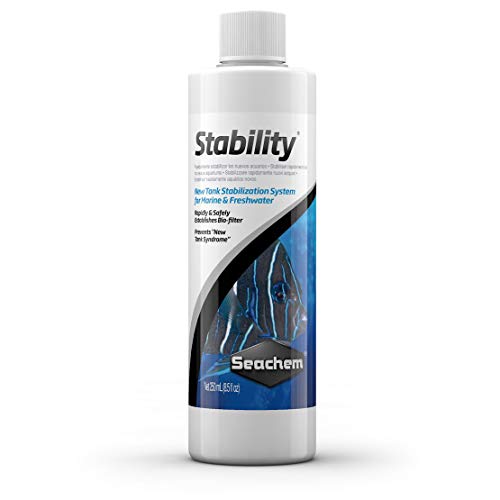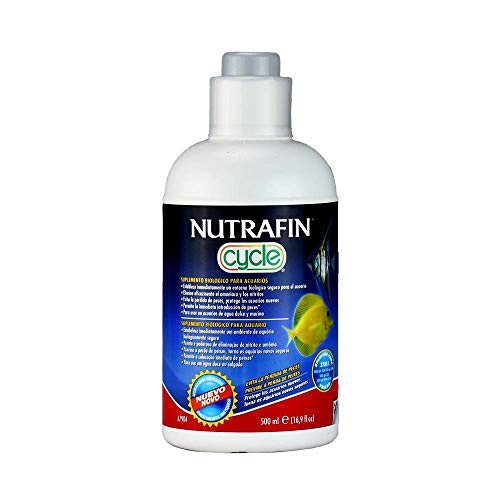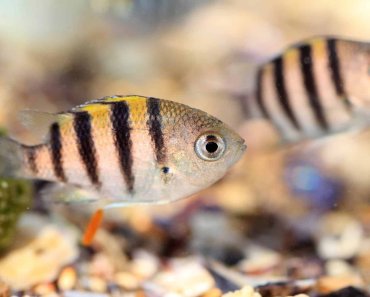If you’re just starting up a new aquarium system, all the various information about the water cycle and nitrogen cycle plus the processes of different beneficial bacteria can get to be a little confusing.
In short, aquarium bacteria supplements will introduce the necessary microorganisms into your fish tank for making the ecosystem sustainable for fish, invertebrates, and other aquatic life. A good population of bacteria is essential for a healthy tank system, and will only come as a result of a completed water cycle as well as stable water conditions.
Keep reading to find out more about the nitrogen cycle, beneficial bacteria, and six of the best aquarium bacteria supplements currently available to kickstart your new fish tank.
What do beneficial bacteria do in the aquarium?
Beneficial bacteria is the basis for a healthy aquarium and facilitates the nitrogen cycle.
In simplest terms, the nitrogen cycle is the process by which ammonia is converted to nitrite, which is then converted into nitrate. Fish and other decaying organisms and matter create ammonia and different kinds of bacteria process that ammonia into less toxic products, like nitrate.
As these bacteria uptake and convert these nutrients, they establish populations on all the surface areas of the aquarium, which is why some filtration media is made to be so porous. This is the process that must occur for a new fish tank to be considered completely cycled.
This process, also known as the nitrogen cycle, is important because both ammonia and nitrite are highly toxic to most aquatic life; nitrate is also toxic, but only at extremely high values.
Without beneficial bacteria in your aquarium, the ammonia would stay in its current state and lead to uninhabitable conditions for fish, invertebrates, and corals.
How do you increase good bacteria in your aquarium?
One of the easiest ways to increase good bacteria in your aquarium is by providing more space for it to grow.
As your fish tank becomes more established, the bacteria population will begin to stabilize itself given the amount of nutrient import, or how many nutrients are entering the system at any given time. Good tank maintenance and water quality will ensure that these bacteria populations have ideal and consistent conditions to thrive.
However, new tanks need an initial source of bacteria for colonies to begin the aquarium cycle after a source of ammonia has been introduced. Facilitating an aquarium cycle can be accomplished in a few ways, such as introducing already-mature filter media from another tank, live rock, or with an aquarium bacteria supplement.
Bacteria supplements can quickly introduce the essential organisms needed to process the nitrogen cycle, making the tank safe for inhabitants; keep in mind that beneficial bacteria will not generate ammonia on their own for the organisms to convert, and most aquarium bacteria supplements will require an external input of ammonia for the organisms to begin the process.
These bacteria supplements may also be used as a fish tank stabilizer for struggling and/or adjusting tanks. They might be best to use if the aquarium has had a recent increase in bioload from added livestock, die off, or that have been recently medicated.
Some hobbyists even like to use supplemental aquarium bacteria after every water change to help restabilize the system, though this is often unnecessary.
The nitrogen cycle in detail
So what is this nitrogen cycle and why is it important for the success of your fish tank?
Nitrogen (N) is an essential chemical element that is used in the composition and workings of DNA and proteins. Nitrogen is found in the atmosphere in the form of N2, where two nitrogen atoms are bonded together; N2 is actually the most abundant molecule in air, making up 78% of the atmosphere as opposed to 21% by oxygen.
Nitrifying bacteria are able to process this N2 by way of nitrogen fixation. These bacteria can be found in soil, water, or may have symbiotic relationships with live plants.
Once nitrogen fixation is completed, the result is ammonia (NH3), which can be directly taken up by plants and later transferred to animals by way of consumption.
The live plants will further process the ammonia into nitrites and nitrates. When these plants are consumed, animals may also incorporate the ammonia into various bodily functionings or pass a form of the ammonia as waste; most aquarium fish usually pass ammonia while elasmobranchs (sharks and rays) pass urea.
The remaining nitrites from these processes are further converted to nitrates, which are less toxic and more readily taken up by both plants and animals for photosynthesis and DNA/protein inclusion respectively.
The remaining nitrates are integrated back into nitrogen gas by facultative bacteria; if nitrate is limited, these bacteria will resort to processing nitrite and other forms of the element.
Nitrogen as a limiting nutrient
Because nitrogen is such an important component of freshwater and saltwater ecosystems, it is usually considered a limiting nutrient. This means that the growth and the population counts of many organisms rely on nitrogen to be in abundance; when nitrogen is limited, those populations and growth rates are also limited.
However, too much nitrogen can lead to eutrophic conditions, where algae and other nuisance plants quickly deplete the water of important nutrients; eutrophication is usually a result of excess phosphates as well.
Once the nutrients have been depleted, the large quantities of plants and algae can no longer sustain themselves, leading to a large die-off. As this organic matter decomposes, bacteria and other microorganisms breakdown what is left and create carbon dioxide as a byproduct.
Not only does this carbon dioxide lower the overall pH of the surrounding area leading to ocean acidification, but it can cause additional die-offs in other distant freshwater and saltwater ecosystems.
Aquarium bacteria supplements
Aquarium bacteria supplements help offset new tank syndrome, which is a blanket term for the problems that often arise in a newly setup freshwater or saltwater aquarium; these problems are usually the result of unfavorable and easily-fluctuating water parameters, mainly with ammonia and nitrite.
The best aquarium bacteria supplements will help lessen the problems that come along with new tank syndrome by introducing the necessary bacteria to quickly detoxify these extreme nutrient levels.
Below, we have listed six of our top aquarium bacteria supplements based on brand, reliability, price, and customer reviews.
Dr. Tim’s One and Only Live Nitrifying Bacteria
One of the best reliable forms of nitrifying bacteria is Dr. Tim’s One and Only. This product is available in 2, 4, 8, 16, 32, 64, and 128 fluid ounce options, with specific bottles for freshwater and marine setups as well; at least 10 mL is needed per 10 gallons (37.9 L) of aquarium water and cannot be overdosed.
Dr. Tim’s introduces live, long-lasting bacteria into the aquarium, that help process ammonia and nitrite until non-toxic levels are reached.
However, a source of ammonia will still need to be introduced to start the process. Some hobbyists have seen a lack of immediate results and did not see any change in levels over the first few weeks. This led them to switch to other products in the meantime.
What we like:
- Largely reliable and long-lasting supplement that does not contain sulfur or cause odors
- Designated options and sizes for freshwater and saltwater fish tanks
- Not possible to overdose if accidentally added too much
What could be better:
- Can take a while to see results/might not see results at all
- Still requires a source of ammonia and a water conditioner
- Larger tanks can be difficult to efficiently dose
- Relatively expensive
API Quick Start Nitrifying Bacteria
API Quick Start Nitrifying Bacteria is a popular method for introducing the bacteria needed to convert ammonia and nitrite into less toxic states. The product is usually offered in 4, 8, 16, or 32 fluid ounce options with designated freshwater and saltwater bottles.
API Quick Start Nitrifying Bacteria is advertised as allowing the hobbyist to immediately add fish once the correct dosage has been dosed into the tank. However, we advise against cycling with livestock and using another source of ammonia instead of relying on live fish to create waste.
In this case, API Quick Start Nitrifying Bacteria will need to be supplemented with an external ammonia source. A water conditioner will also still be necessary to remove chlorine and other heavy metals.
Overall, hobbyist reviews find that API Quick Start Nitrifying Bacteria is more effective when added to an established aquarium rather than to a new tank. It is recommended to use this product whenever adding new fish or other bioloads to the aquarium as well as when performing water changes.
What we like:
- Effective for introducing additional bacteria into the tank
- Best when used for adding fish, offsetting an additional bioload, or performing water changes
- Many different sizes and aquarium system options
- Relatively inexpensive
What could be better:
- Included ammonia source
- Included water conditioner
Seachem Stability Fish Tank Stabilizer
- TANK STABILIZATION: Seachem Stability will rapidly and safely establish the aquarium biofilter in freshwater and marine systems, thereby preventing the #1 cause of fish death: “new tank syndrome”.
- TREATMENT: Stability is formulated specifically for the aquarium and contains a synergistic blend of aerobic, anaerobic, and facultative bacteria which facilitate the breakdown of waste organics,…
- BACTERIA GROWTH: The necessary conditions for the growth of Stability’s bacteria strains encompass a very broad range. When other bacteria begin to die off (usually from high organic loads caused by…
Seachem Stability Fish Tank Stabilizer helps reduce and eliminate ammonia, nitrite, and nitrate with resistant strains of aerobic, anaerobic, and facultative bacteria.
The typical product size is one 500 mL designed for both saltwater and freshwater fish tanks in mind. 5 mL should be dosed on the first day for every 10 gallons (37.9 L) of water and then 5 mL for every 20 gallons (75.7 L) of water over the next 7 days.
Like the previous products, Seachem Stability requires an additional source of ammonia to initially feed the bacteria. Reviews also state that the product is not fully effective unless used together with Seachem Prime, which is a concentrated water conditioner that also helps detoxify ammonia, nitrite, and nitrate.
What we like:
- Short, one week dosage period
- Designed for both saltwater and freshwater fish tanks
- Hardy bacteria that doesn’t require specific water/tank conditions
- Relatively inexpensive
What could be better:
- Requires ammonia source
- Does best when paired with Seachem Prime which is an additional cost
Instant Ocean BIO-Spira Water Treatment for Aquariums
Instant Ocean BIO-Spira Water Treatment for Aquariums will accelerate the water cycle of a new fish tank considerably. This beneficial bacteria supplement comes in two sizes, 3.38 fluid ounces and 8.45 fluid ounces, and is designed specifically for saltwater aquariums; 5 mL treats 10 gallons (37.9 L) of water.
Like the previous bacteria supplements products, Instant Ocean BIO-Spira neutralizes ammonia and nitrite through live nitrifying bacteria, like Nitrococcus, Nitrosomonas, Nitrosospira, and Nitrospira.
Conveniently, this product only needs to be dosed once and the effects can usually be seen immediately. Instant Ocean BIO-Spira does not need to be refrigerated and has a moderate shelf life. Still, it is necessary to use a water conditioner when dosing this supplement.
What we like:
- One time, quick dosage
- Exact types of aquarium bacteria listed
- Does not need to be refrigerated and has a moderate shelf life
- Relatively inexpensive
What could be better:
- Only for saltwater aquariums
- One time dosage can make it difficult to record results over time
Fluval Biological Enhancer for Aquarium
This aquarium bacteria supplement does not seem to be as immediate as the other options available and might be better when used as a bacteria booster instead of as a means for cycling a new tank.
Fluval Biological Enhancer for Aquarium comes in an assortment of sizes, with 1.0, 4.0, 8.4, 16.9, and 64.0 fluid ounce bottles, treating both saltwater and freshwater aquarium setups. The smaller sizes make this brand especially appealing for those with a betta fish tank or smaller systems that might not need such a large bottle.
To find out more about why betta fish need a cycled tank just as much as other fish do, make sure to check out this guide here.
Reviews have found that this supplement balances water parameters within 3 weeks of setting up a new aquarium; this is only a little shorter than the typical 4-6 weeks it takes to cycle aquarium water otherwise. It is also important to note that this product is equally advertised as being efficient at replacing depleted bacteria populations during water changes as well as when filter media is changed.
What we like:
- Variety of sizes for any freshwater or saltwater aquarium
- Cycles aquarium water faster than natural methods
- Useful for bolstering bacteria populations during water changes and filter media cleanings
What could be better:
- Still takes several weeks to fully cycle aquarium water
- Mainly used for replacing already-existing bacteria
Nutrafin Cycle Biological Filter Supplement
- Fast-acting responsive ammonia and nitrite elimination
- Consistent performance from each container due to bio-floc technology for improved shelf life and product viability
- Ensures that biological pollutants produced by fish are rapidly converted to a non-harmful compound
If you haven’t had luck with any of the other aquarium bacteria supplements in your fish tank, then you might want to start looking at some of the more overlooked products, like Nutrafin Cycle Biological Filter Supplement.
This product is available in an 8.4 fluid ounce or 16.9 fluid ounce bottle and is designed for both saltwater and freshwater aquariums. Many reviews have said that they saw results as early as the first three days and as late as ten days.
Nutrafin Cycle Biological Filter Supplement has been specially engineered with bio-floc technology for improved shelf life. This supplement may not be as effective as the others when facing high ammonia and nitrite levels but does well at keeping water conditions in check.
However, like the others, a source of ammonia and a water conditioner is necessary for seeding the new tank.
What we like:
- Designed for both saltwater and freshwater needs
- Almost immediate results and timely water cycle
- Improved shelf life for later use
What could be better:
- The expiration date is often not labeled on the bottle
- Need a source of ammonia and water conditioner
- Relatively expensive
How often should you add bacteria to your aquarium?
For established tanks, it isn’t usually necessary to add additional bacteria; as long as the nutrient import and export in the system is balanced, then a mature tank should be able to maintain itself. Of course, regular water changes and other tank maintenance will need to be kept up with as well to really keep the system balanced.
Beneficial bacteria are usually added to help facilitate the water cycle in a new tank; each product will have different instructions on dosage amount and frequency, which can usually be found right on the back of the bottle or online.
Some hobbyists also choose to supplement nitrifying bacteria when adding new fish, performing aquarium maintenance, or if medications have recently been used. Many of these products cannot be overdosed, and it can be helpful to give your tank the boost it needs during these changes.
Can you add too much beneficial bacteria to a tank?
It depends on the product being used, but in general, beneficial bacteria cannot be overdosed; always make sure to read the instructions on the back of the bottle first, though!
The amount of nitrifying bacteria in your tank is based on the amount of ammonia in your system. Populations will correct themselves as the levels fluctuate and stabilize as ammonia increases and decreases. They will eventually find a natural balance in your system once your tank starts to become more mature.
Some bacteria also use air (aerobic bacteria) for these processes, and larger populations will mean that more oxygen is needed in the water column. However, it is very unlikely for an aquarium to have such large colonies of nitrifying bacteria where bacteria die-off causes ammonia spikes or there are other issues with balancing oxygen and carbon dioxide.
As long as you make sure to follow the directions on the bottle, then you should have no problems!
Other methods
There are many methods for cycling a new aquarium, and each method is dependent on the specific setup. While some popular methods might work for some tanks, that particular way might not have any effect on your own saltwater or freshwater aquarium!
Dosing ammonia
With any new tank, ammonia needs to be fed into the system to allow nitrifying bacteria to establish and grow. Some hobbyists dose pure ammonia (NH3) directly into the water column which makes for a clean and calculable way to start the cycle.
Others use commercially frozen shrimp that is left to rot and leak out ammonia or turn to popular aquarium products instead.
Dosing ammonia directly is one of the simplest and cleanest methods as shrimp can start to smell and become unsightly. However, the benefit is that decaying organic matter also helps introduce other nutrients and feeds microorganisms that could help your tank in the beginning stages.
Aquarium products tend to be more expensive and less straightforward than using shrimp as it can sometimes be difficult to determine the exact ingredients used and their effects.
Existing filter media
Some hobbyists are able to skip the initial new tank syndrome entirely if they have access to media from an already-established system. For example, filter media can easily be transferred from one tank to another and already holds healthy populations of live nitrifying bacteria.
For saltwater aquariums, live rock houses most of the beneficial bacteria needed to kickstart a new tank and can be transferred between tanks; however, if the live rock has been kept out of water for extended amounts of time, there is a good chance that die-off will occur and a mini cycling process will restart.
Once the ammonia has been introduced by one of these means, nitrifying bacteria need to establish their populations.
At this point, it is time to use the best aquarium bacteria product available for your tank. For freshwater aquariums, aquatic plants may also be added to help uptake nutrients; however, this can result in a ‘silent’ cycling process, making it difficult to know whether or not the tank is fully cycled.
Once ammonia and nitrite levels are 0 ppm and there are detectable amounts of nitrate, then it is best to do a large water change. After that, the cycling process should be done and your tank should be ready for fish and invertebrates!
Fish-in cycle
As mentioned before, we do not recommend adding fish or invertebrates until the water cycle has fully completed. Ammonia and nitrite are highly toxic and can quickly lead to dead livestock, prolonging the cycle even more.
However, it is possible to add aquarium plants and some corals as they actually help uptake nutrients and facilitate the water cycle; always make sure to do research about the aquarium plants or corals you plan on adding as some may not be able to withstand extreme and/or variable water conditions.
Conclusion
Some hobbyists believe that aquarium bacteria supplements and fish tank stabilizer products are completely ineffective and not worth the time. However, many hobbyists have found bacteria supplements to help their aquariums in one way or another, be it through when setting up a new tank, performing water changes, or having recently medicated the aquarium water.
The best nitrifying bacteria supplement product will depend on tank size and desired results. While many of these aquarium bacteria supplements may help jump-start a fish tank through its water cycle, we do not recommend adding fish until the system has completely cycled.
If you have any questions about the best aquarium bacteria supplement to use, the water cycle, the nitrogen cycle, or have had experience with bacteria supplements in your fish tank, don’t hesitate to leave a comment below!




























